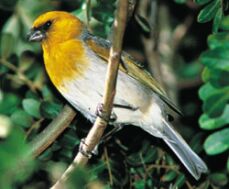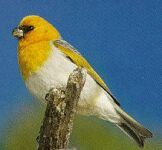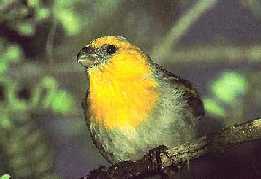





The Palila is a large-billed, large-headed bird about 15.25 cm long with a golden-yellow head and throat but with a gray back; the abdomen is grayish white; the lores are blackish; the bill is dark in color and is not hooked or parrot-like. The female's throat and breast are duller than in the male; the crown is only slightly yellowish.

The present habitat of the Palila is the subalpine mamane-naio (Sophora chrysophylla-Myoporum sandwicense) woodland on Mauna Kea. Palila are found from 2,000 to 2,850 m elevation in woodlands with at least 5% canopy cover and of 2-10 m height. The Palila shows habitat preferences because densities of birds can be as much as 100 times greater in some habitat types than in others. The species prefers areas with greater crown cover, taller trees, and higher proportion of native plants in the understory. Possibly some of the areas meeting the minimal habitat requirements would be unable to sustain a population; the birds occurring in these areas at present may merely represent population overflow or dispersal. An area of possible occurrence includes the sparse woodlands and open pastures with scattered trees on the northern and northwestern slopes of Mauna Kea, in the Humu'ula Saddle, and on the eastern slopes of Mauna Kea.

Nest trees average 6.9 m in height and 83.4 cm in circumference at breast height. Both of these measurements are near the maximum for trees in the area. Nest placement averages 5.2 m above ground, and are placed on horizontal branches, some on terminal or lateral forks.
The staple food item of Palila is the green, fully-inflated pods of the mamane tree (Sophora chrysophylla); other food items contributing significantly to the diet include mamane flowers, mamane leaf buds, mamane flower buds, naio (Myoporum sandwicense) flowers, naio berries, and insects. Little is known about seasonal variation in the food parts consumed. Juvenile and adult diets are similar.

Threats to this bird?
Habitat destruction of low elevation dry forests and woodlands by Hawaiians probably significantly reduced the range of the Palila during the period from 400 A.D. to perhaps 1000 A.D. Palila were extirpated from Kona between 1896 and 1936, probably as a response to the spread of avian diseases, particularly malaria and pox. Feral ungulates - first cattle, then sheep and to a lesser extent goats, and now (1985) mouflon - have had a severe impact on the mamane-naio ecosystem on Mauna Kea. The degradation and fragmentation of the subalpine woodland by feral ungulates followed in some areas by erosion, has contributed greatly to the reduction in range and population size of the Palila. Fire affected several hundred hectares in 1979. Predators [black rats (Rattus rattus, cats (Felis catus)] doubtlessly have some impact on the population, but this has not been quantitatively studied. Climate affects the population through droughts and storms; production of the chief food item is related to rainfall. Palila are absent or very rare in apparently good habitat in the Pohakuloa Flats area; probable causes are excessive disturbance from military activity (explosions, off-road vehicles, etc.), disease, high temperatures, food supply shortages at certain seasons, and site tenacity.
For information on captive breeding programs that seek to increase the population of endangered Hawaiian birds, call the Peregrine Fund at 808-985-7218.
Hawaiian Bird Conservation link:
http://peregrinefund.org
http://oocities.com/endangeredsp/ This Information Brought To You By This Site
This page hosted by  Get your own Free Home Page
Get your own Free Home Page

















